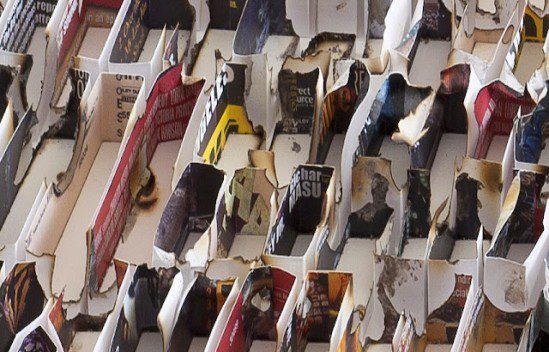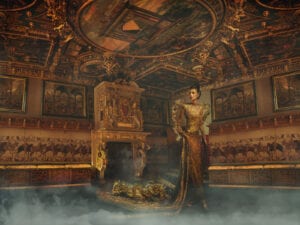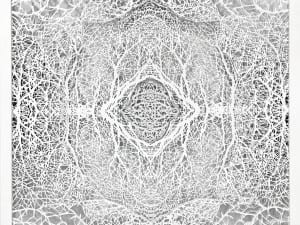Text by Bethany Rex
Cities are often described as living organisms; viewed as subject rather than object. Matthew Picton engages with this traditional of humanising the city by deconstructing the clean, uncompromising aesthetic of the cartographic city plan and imbuing it with the unique history and culture of each place.
For this exhibition Urban Narratives, Picton depicts these cities as active participants, affected by outside sources and shaped by their internal social structure. They city becomes a subject and an entity of its own.
BR: Urban Narratives opened earlier this month. What has the response to the work been like so far?
MP: It has been extremely positive so far, very well attended at the special evening for the young diplomats of London and the LSE Alumni, we had many interesting questions and received some good input and thoughts. People seemed excited by the work, and that’s important to me.
BR: What do people understand the work to be about?
MP: It’s about cities, urban life, history and the perspectives given by literature. There is a clear understanding of the work’s depiction of the vulnerability of human civilisation. People also clearly recognise the work to be about mapping and will locate their own personal narratives within the cartographic framework.
BR: Could you talk us through your relationship with the concept of the city? Where did this begin?
MP: My relationship with the concept of the city is an ever expanding one. I started seeing the city as akin to an organisation but what I increasingly see is something more akin to an accumulation of humanity stretching back centuries. A city as an accumulated depositary of culture and the progress of civilisation, a body which has grown through the tumults and events of history. I always begin with an excitement about a city, an enthusiasm that is found in the imagination of it’s history and visual appearance, which leads to an imagination of what a life within the city might be like, or has been like.
BR: I’ve been reading about your work, and your research must be meticulous. What’s your favourite place to think about what you’ll make next?
MP: Looking out of the window on a long flight. The view from high up has always intrigued me, particularly the macro aerial perspective offered by the plane seat. Again not unlike looking at a map, except here starting to imagine past the immediate visual gratification of the geography and on to thinking about the social and historical components of the landscape.
BR: We’ve got a shared love for Thomas Mann. Is there something particular about Death in Venice that inspired you?
MP: The wonderfully poetic and evocative nature of the writing and it’s mirroring of the decline and slow death through the centuries of Venice. All of course put into the very personal and human terms of the decline of the central character, Aschenbach as he follows his obsession.
BR: Where on the map do you hope to transform next?
MP: I am particularly excited about making a sculpture of St. Petersburg. I am planning to use a map from the early 19th century that depicts the extent of the flood waters of the year 1997. I anticipate travelling there to collect some of the Nevsky water and mud. The work will encompass some of Russian poet Joseph Brodsky’s writings and poetry; writing that reflects upon the transition of St. Petersburg to Leningrad and back again, writing that reflects the mythology of St. Petersburg in Russian Literature. The work with also include portions of Shostakovich’s 7th Symphony, which was written about the gruelling 3 year siege of St. Petersburg. Thus it will be a work reflecting different eras and transitions in the history of this city.
Matthew Picton: Urban Narratives, 08/03/2012 – 06/04/2012, Sumarria Lunn, 36 South Molton Lane, Mayfair, London, W1K 5AB. www.sumarrialunn.com
Aesthetica in Print
If you only read Aesthetica online, you’re missing out. The February/March issue of Aesthetica is out now and offers a diverse range of features from an examination of the diversity and complexity of art produced during the tumultuous decade of the 1980s in Art, Love & Politics in the 1980s, opening 11 February at MCA Chiacgo, a photographic presentation of the Irish Museum of Modern Art‘s latest opening, Conversations: Photography from the Bank of America Collection. Plus, we recount the story of British design in relation to a comprehensive exhibition opening this spring at the V&A.
If you would like to buy this issue, you can search for your nearest stockist here. Better yet call +44 (0) 1904 629 137 or visit the website to subscribe to Aesthetica for a year and save 20% on the printed magazine.
Captions:
1. Hollywood Crushed and Burned (2010)
A sculptural map of Hollywood created from the covers of the fictional film Earthquake (1974) and the documentary Killer Quake (2004). The work provides a fictional dramatisation of imagined and future earthquakes as well as imagery from the actual Los Angeles earthquakes of 1989 – 1994. Film and documentary are as much bound up with the history and future of LA as the fault lines that sit beneath it and it seems fitting here that the two converge in the sculpture.
2. Lower Manhattan (2011)
Lower Manhattan if the first “smoked” sculpture Picton has made. The complex cartography of the city plan was created from the headlines that followed the 2001 World Trade Center tragedy, DVD covers of the film Towering Inferno and book covers of the novel The Plot Against America by Philip Roth. The finished work has been carefully “smoked” from the site obscuring the colour of the sculpture. Without doubt this event will take its place in human history and has already shaped the lives of those in the city, the country and many more around the world.
3. Portland (2011)
Created from the covers and text of the novel The Lathe of Heaven by Ursula LaGuin and the DVD covers of the films Dante’s Peak and Volcano.




